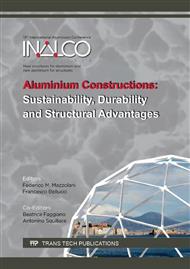p.231
p.238
p.244
p.250
p.256
p.262
p.268
p.275
p.281
Experimental and Numerical Researches on Aluminium Alloy Systems for Structural Applications in Civil Engineering Fields
Abstract:
Structural research and applications of aluminium structures in civil engineering field have grown extensively in the last decades. Low weight, corrosion resistance, production of special profiles by extrusion and aesthetic quality of the aluminium material, together with the availability of specific and detailed design codes at both Italian (CNR-DT 208/2011) and European (Eurocode 9) level, have furthered such a development.On the other hand, in recent years, several experimental and numerical researches have been developed in order to improve the comprehension of the structural behaviour of aluminium elements, such as extruded and welded members, connections and joints, special devices, giving an important contribution to the present structural codes.This paper gives an overview of some of the researches developed recently by the authors which are strictly connected to the design and innovation of aluminium alloy structures. In particular, the behaviour of aluminium alloy members, joints and seismic protection devices is analysed, illustrating the results obtained by the above research programs. They put into evidence interesting aspects that deserve further research activities for improving the present codes on aluminium structures, as well as the high potentiality of the aluminium material to be used as alternative to steel for interesting and convenient applications in structural engineering.
Info:
Periodical:
Pages:
256-261
Citation:
Online since:
September 2016
Price:
Сopyright:
© 2016 Trans Tech Publications Ltd. All Rights Reserved
Share:
Citation:


